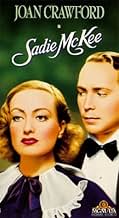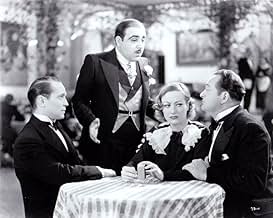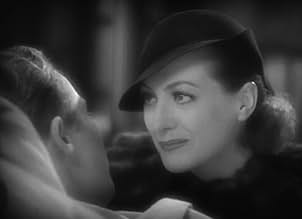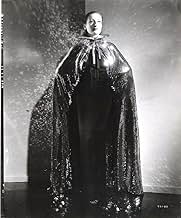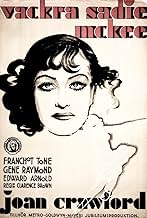VALUTAZIONE IMDb
6,8/10
1786
LA TUA VALUTAZIONE
Aggiungi una trama nella tua linguaA working girl's fortunes improve when she marries into money, but happiness is not so easily won.A working girl's fortunes improve when she marries into money, but happiness is not so easily won.A working girl's fortunes improve when she marries into money, but happiness is not so easily won.
- Regia
- Sceneggiatura
- Star
- Premi
- 3 vittorie totali
Leo G. Carroll
- Phelps
- (as Leo Carroll)
Candy Candido
- Cafe Entertainer
- (as Candy and Coco)
Otto Heimel
- Cafe Entertainer
- (as Candy and Coco)
Norman Ainsley
- Second Butler - at Downstairs Meeting
- (non citato nei titoli originali)
Hooper Atchley
- Intern with Dr. Briggs
- (non citato nei titoli originali)
Nellie Bly Baker
- Downstairs Laundress
- (non citato nei titoli originali)
Jack Baxley
- Short-Order Cook
- (non citato nei titoli originali)
Recensioni in evidenza
Well-made Clarence Brown pre-Code soaper with Joan Crawford (Brown directs Joan 5 times) costumed by Adrian (he does this a total of 28 times) and photographed by Oliver T. Marsh (he did a total of 15 films with Joan). First class production crew yields a first class film.
Joan plays a `shopgirl' character that could have had no heart (Barbara Stanwyck would have excelled at such an interpretation) but the writers gave her an innate goodness that warms Sadie McKee to her audience. Edward Arnold stands out as the drunken millionaire that must have served as a role model for Dudley Moore years later in `Arthur.' His sock in the jaw to Joan is unexpected and looks very real. Gene Raymond does well as the love interest and if that was he singing he did it well. His final scene is very good and somewhat unusual. Franchot Tone does not appear to have had the opportunity to develop his character sufficiently to make him more effective. It must have been good enough, because he got Joan after the film was completed. A somewhat zaftig Esther Ralston still manages to demonstrate why she was `The American Venus' and why Raymond spent so much of his time smiling. Why her character does not react to Raymond singing a love song to Joan in the Apollo Theater is beyond me. Leo G. Carroll does a superb job as the butler his distain for the lower class Joan is great.
Joan's character has many choices in this film and she generally comes out ahead with some short deviations into taking what she can get when she can get it. She gives great looks at Arnold when she realizes she must be his lover now that they are married and later to her friend when she exclaims, `So I've got everything, huh?' and while reflecting what she has done after throwing Tone out of her house. Arnold also has choices and responds well to the outcome of the marriage. Although the two policemen in the film do not take the `tip' offered by Joan, they run out after the taxicab man who gets their share presumably to get their cut out outside the presence of Joan.
This is excellent movie making and a must see for Joan Crawford fans (or anyone else that wants to see a good movie). Highly recommended.
Joan plays a `shopgirl' character that could have had no heart (Barbara Stanwyck would have excelled at such an interpretation) but the writers gave her an innate goodness that warms Sadie McKee to her audience. Edward Arnold stands out as the drunken millionaire that must have served as a role model for Dudley Moore years later in `Arthur.' His sock in the jaw to Joan is unexpected and looks very real. Gene Raymond does well as the love interest and if that was he singing he did it well. His final scene is very good and somewhat unusual. Franchot Tone does not appear to have had the opportunity to develop his character sufficiently to make him more effective. It must have been good enough, because he got Joan after the film was completed. A somewhat zaftig Esther Ralston still manages to demonstrate why she was `The American Venus' and why Raymond spent so much of his time smiling. Why her character does not react to Raymond singing a love song to Joan in the Apollo Theater is beyond me. Leo G. Carroll does a superb job as the butler his distain for the lower class Joan is great.
Joan's character has many choices in this film and she generally comes out ahead with some short deviations into taking what she can get when she can get it. She gives great looks at Arnold when she realizes she must be his lover now that they are married and later to her friend when she exclaims, `So I've got everything, huh?' and while reflecting what she has done after throwing Tone out of her house. Arnold also has choices and responds well to the outcome of the marriage. Although the two policemen in the film do not take the `tip' offered by Joan, they run out after the taxicab man who gets their share presumably to get their cut out outside the presence of Joan.
This is excellent movie making and a must see for Joan Crawford fans (or anyone else that wants to see a good movie). Highly recommended.
I'd have to describe Sadie McKee as both the typical Joan Crawford vehicle and the typical Franchot Tone vehicle. The two of them who were husband and wife when the film was made are perfectly cast in roles that typified their images in the Thirties.
Crawford is the daughter of a cook on the sumptuous palatial Long Island estate where Tone is the young heir and a lawyer by trade. To earn a few extra bucks Crawford occasionally helps mom out serving at formal meals.
At one of those meals she hears Tone disparaging her sweetheart Gene Raymond who was caught in a petty theft. Tone makes a big point in saying we can't give people like these help because they're no good. Crawford throws a fit and runs to Raymond.
She almost marries Raymond, but he runs out on her for Esther Ralston. In New York working as a nightclub cigarette girl she runs into Edward Arnold who is a millionaire with a severe drinking problem. No doubt caused by drinking a lot of rotgut liquor during recently repealed Prohibition. And wouldn't you know it, Tone is his lawyer.
So Sadie has her three men, give you one guess who she winds up with in the end. You'd probably guess right, but let's say it's a character altering experience for all.
Sadie McKee is probably a good example of the Joan Crawford shop girl before she became a hardened creature like Crystal Allen in The Women. As for Franchot Tone, MGM just loved casting him as rich men in a tuxedo, probably because he looked so darn good in them. The only way either of them escaped type casting was as they got older they varied their parts due to age. Crawford was ever the film star, even in some of the horror flicks she did in the sixties. Tone went right into television and worked steady right up to his death.
Sadie McKee however is a good opportunity to see them both young and at the height of their fame. Also note the Nacio Herb Brown-Arthur Freed ballad All I Do Is Dream Of You comes from Sadie McKee.
Crawford is the daughter of a cook on the sumptuous palatial Long Island estate where Tone is the young heir and a lawyer by trade. To earn a few extra bucks Crawford occasionally helps mom out serving at formal meals.
At one of those meals she hears Tone disparaging her sweetheart Gene Raymond who was caught in a petty theft. Tone makes a big point in saying we can't give people like these help because they're no good. Crawford throws a fit and runs to Raymond.
She almost marries Raymond, but he runs out on her for Esther Ralston. In New York working as a nightclub cigarette girl she runs into Edward Arnold who is a millionaire with a severe drinking problem. No doubt caused by drinking a lot of rotgut liquor during recently repealed Prohibition. And wouldn't you know it, Tone is his lawyer.
So Sadie has her three men, give you one guess who she winds up with in the end. You'd probably guess right, but let's say it's a character altering experience for all.
Sadie McKee is probably a good example of the Joan Crawford shop girl before she became a hardened creature like Crystal Allen in The Women. As for Franchot Tone, MGM just loved casting him as rich men in a tuxedo, probably because he looked so darn good in them. The only way either of them escaped type casting was as they got older they varied their parts due to age. Crawford was ever the film star, even in some of the horror flicks she did in the sixties. Tone went right into television and worked steady right up to his death.
Sadie McKee however is a good opportunity to see them both young and at the height of their fame. Also note the Nacio Herb Brown-Arthur Freed ballad All I Do Is Dream Of You comes from Sadie McKee.
"Sadie McKee" was made just before Hollywood got serious about sanitizing its content, and the movie is set squarely in what we now call the pre-Code world. In this world, men are on the make, cops are on the take, rich people do pretty much as they please and prostitution is just another job option.
But while many other pre-Code film can leave you with a bleak feeling about human nature, this one is stocked with basically decent characters. Bribe-takers are just ordinary folks trying to get by. A clever seducer can't silence his own conscience. And when an aging, drunken millionaire orders up a young girl and takes her home for the night, the relationship quickly blossoms from exploitation into an odd kind of love.
Joan Crawford plays the title role, a plucky survivor whose ups and downs would have broken a lesser person. Gene Raymond, Franchot Tone and Edward Arnold play the three very different men in her life. The story is improbable at times, moving from flophouse to sleazy nightclub to mansion. But it's never gets so unrealistic that you stop caring. The ending is somewhat enigmatic, at least to me. I'm still wondering exactly where everyone stood at the end, and where things were headed. That's OK. I like a movie that leaves a little something nagging at you.
If the story is improbable, there's nothing unbelievable about how Joan Crawford's character turns men's heads. A lot of people still view Crawford through a "campy" lens, remembering her long years as a fading star with a lot of personal baggage (real and reputed). Forget all that stuff. In 1934 she was young and lithe and simply gorgeous. She carries this movie, and she carries it well.
But while many other pre-Code film can leave you with a bleak feeling about human nature, this one is stocked with basically decent characters. Bribe-takers are just ordinary folks trying to get by. A clever seducer can't silence his own conscience. And when an aging, drunken millionaire orders up a young girl and takes her home for the night, the relationship quickly blossoms from exploitation into an odd kind of love.
Joan Crawford plays the title role, a plucky survivor whose ups and downs would have broken a lesser person. Gene Raymond, Franchot Tone and Edward Arnold play the three very different men in her life. The story is improbable at times, moving from flophouse to sleazy nightclub to mansion. But it's never gets so unrealistic that you stop caring. The ending is somewhat enigmatic, at least to me. I'm still wondering exactly where everyone stood at the end, and where things were headed. That's OK. I like a movie that leaves a little something nagging at you.
If the story is improbable, there's nothing unbelievable about how Joan Crawford's character turns men's heads. A lot of people still view Crawford through a "campy" lens, remembering her long years as a fading star with a lot of personal baggage (real and reputed). Forget all that stuff. In 1934 she was young and lithe and simply gorgeous. She carries this movie, and she carries it well.
I'm a big fan of the Crawford oeuvre, in all its permutations and occasional excesses. That said, her Sadie is refreshingly underplayed and sincere. The mid-Atlantic accent that she tended to is at a minimum here, and there is a fluidity that is in much contrast to the Greek tragic masks, riveting though they are, of some of her later performances. The wonderful Jean Dixon is on hand in a role that is a precursor to Eve Arden's pal of "Mildred Pierce" and "Goodbye My Fancy"--worldly, rueful, self-denigrating. (Mary Phillips took on a similar part in "The Bride Wore Red" several years later.) Esther Ralston does a fine job as the blowsy, sensuous man-stealer--at one point she practically does a Mae West with her intonations and stance. Solid performances also from Franchot Tone and Gene Raymond and the always-reliable, under-appreciated Edward Arnold. The very engaging Earl Oxford appears as "the Stooge" and one wonders why this charmer did not have a film career.
The story is serviceable, and there is a motif of characters' taking responsibility for their lives, and, as best they can, making amends for wrongs. Note that at the start and end of the film there are scenes in which the camera follows a character from one room to the next in such a way that you realize that there is not any real partition between the two rooms--an enjoyable little breaking of the "fourth wall" premise of theater.
The story is serviceable, and there is a motif of characters' taking responsibility for their lives, and, as best they can, making amends for wrongs. Note that at the start and end of the film there are scenes in which the camera follows a character from one room to the next in such a way that you realize that there is not any real partition between the two rooms--an enjoyable little breaking of the "fourth wall" premise of theater.
In Richley, New York, Sadie McKee (Joan Crawford) works as a maid in the Alderson mansion where her mother is the cook. When the son of their employee, the successful lawyer Michael Alderson (Franchot Tone) that was raised with her, returns from New York after two years, his family offers a dinner party to family and friends. While serving soup, Sadie hears the comments made by Michael about her boyfriend Tommy Wallace (Gene Raymond), who was fired from the Alderson factory accused of being a dishonest person. Sadie reacts and tells that they are insensitive. Sadie decides to flee with Tommy to New York to get married and find job. They befriend Opal (Jean Dixon) and she takes them to the low- budget boardinghouse where she lives. On the next morning, Sadie leaves the boardinghouse to seek a job and marry her beloved Tommy. But his next room neighbor Dolly Merrick (Esther Ralston) overhears him singing and seduces Tommy to travel with her in an itinerant show business. Sadie prepares to return home, but Opal convinces her to stay and finds a job of dancer in a nightclub. Ten days later, Sadie is helped by an alcoholic costumer to get rid of an abusive one and he invites her to join him at his table. She learns that he is the millionaire Jack Brennan (Edward Arnold) and his friend is Michael Alderson. When Michael patronizes her telling to leave Jack, she is still angry with Michael and stays with Jack that proposes to marry her. She accepts and is seen by the society as a gold-digger. But Sadie is still in love with Tommy. What will happen to her?
"Sadie McKee" is a Pre-Code drama with the story of a working girl in love with a rascal that marries a wealthy girl. The role is perfect for Joan Crawford. The amoral story has a great open conclusion where the viewer needs to guess the birthday wish of Michael. My vote is six.
Title (Brazil): "Três Amores" ("Three Loves")
"Sadie McKee" is a Pre-Code drama with the story of a working girl in love with a rascal that marries a wealthy girl. The role is perfect for Joan Crawford. The amoral story has a great open conclusion where the viewer needs to guess the birthday wish of Michael. My vote is six.
Title (Brazil): "Três Amores" ("Three Loves")
Lo sapevi?
- QuizOne of the first films to treat alcoholism as a serious problem, instead of a comic device.
- BlooperWhen Tommy is in his hospital room he makes Dr. Briggs promise not to tell Sadie of his condition. However, when Dr. Briggs leaves the room, Sadie is there with the other doctors and she already knows. Dr. Briggs then says, "He made me promise he wouldn't tell her." This dialogue obviously makes no sense and is wrong. What he meant to say was, "He made me promise not to tell her."
- Citazioni
Sadie McKee Brennan: [showing off her bedroom] Here it is.
Opal: Lady, when you say, "I do take thee," how you take him.
Sadie McKee Brennan: [chuckles]
Opal: Got this all to yourself?
Sadie McKee Brennan: Yep, all to myself.
Opal: Always all to yourself?
Sadie McKee Brennan: Yep.
Opal: Well, a whole lot of us do a whole lot more for a whole lot less.
- ConnessioniFeatured in Che fine ha fatto Baby Jane? (1962)
- Colonne sonoreAll I Do Is Dream Of You
(1934) (uncredited)
Music by Nacio Herb Brown
Lyrics by Arthur Freed
Played during the opening credits
Sung by Gene Raymond three times
Sung also by Earl Oxford in a show
I più visti
Accedi per valutare e creare un elenco di titoli salvati per ottenere consigli personalizzati
- How long is Sadie McKee?Powered by Alexa
Dettagli
Botteghino
- Budget
- 612.000 USD (previsto)
- Tempo di esecuzione1 ora 33 minuti
- Colore
- Proporzioni
- 1.37 : 1
Contribuisci a questa pagina
Suggerisci una modifica o aggiungi i contenuti mancanti

Divario superiore
By what name was Sadie McKee (1934) officially released in India in English?
Rispondi
